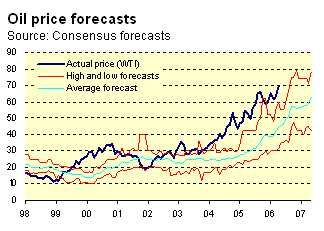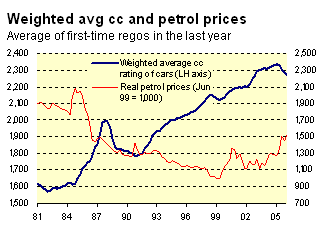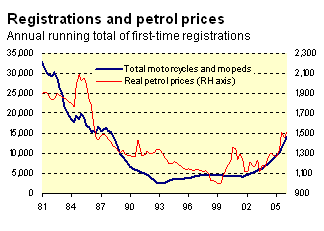Double, double, oil and trouble
Petrol prices in the March quarter were at their highest level, in real terms, since 1986. This article examines the outlook for oil prices, their effect on people’s behaviour, and the resultant impact on monetary settings and the broader New Zealand economy.
Always hoping for the best
Recent trends in oil prices have proved difficult for forecasters to predict. Since early 2002, the market has consistently been expecting oil prices to drop back from their current levels. Graph 8.1 shows forecasts of oil prices from the Consensus publication and compares them with the actual result a year later. It has been four years since the consensus forecast for 12 months down the track was not too high. In fact, only once in the last 2 ½ years has the actual oil price fallen within the range provided by contributors to the publication.

Graph 8.1
This persistent bias of underestimating future oil pricesis present in our own forecasts:
- February 2003: "Our prediction is a brief spike to approximately US$45 per barrel lasting six months".
- June 2004: "In the short-term (up to the end of 2004) we expect the peak in prices will be somewhere in the $40-50/bl range".
- August 2004: "Our prediction - was that oil prices would peak somewhere between US$40-50/bl before easing off - We see no need to change this forecast."
- October 2005: "We predict that oil prices will settle consistently below US$50/bl within the next 18 months".
The jury’s still out on that last forecast. Events in the short-term, such as reduced political tensions in the Middle East or Nigeria, or slower economic growth and weaker demand from China for oil, have the potential to push oil prices lower. But the medium-term trend in oil prices is likely to remain upward, given the ever-increasing global demand for oil and concerns about supply.
Higher prices encourage the extraction of crude oil that would not be profitable to pursue at lower prices. Higher prices also encourage more efficient use of petroleum products by businesses and households, and ultimately lead to investment in alternative technologies allowing users to switch away from oil consumption. However, these factors help to cap rises in oil prices over the medium-term; they will not drive the price of oil lower.
Time to make a change
As we’ve noted on previous occasions, even if world oil prices do retreat from their current levels of close to US$70/bl, the impact on retail petrol prices in New Zealand is likely to be offset by the current downward trend in our dollar. More expensive fuel is something we simply have to get used to.
So is this leading to changes in behaviour? In terms of vehicle-purchasing behaviour, it appears that it is. Graph 8.3 shows the weighted average cc rating [1]of first-time registrations and real petrol prices. The 2.7% drop in the weighted average cc rating over the last year is the largest fall since the excesses of the mid-1980s (share market boom) were being unwound between 1987 and 1989.

Graph 8.2
Even more obvious is the turn around in motorcycle and moped registrations. Over the last four years, the number of first-time registrations of these vehicles has trebled to 14,200pa. The number of moped registrations has surged almost 500% during that time.
With the exception of the figures for mopeds, the changes in registration numbers are still relatively small by historical standards. However, the changes in behaviour are much clearer than they were during the petrol price spike in 2000. The efforts from households to reduce consumption are evident in delivery statistics of petrol – down 2.9% for the year ended March (the largest drop in 20 years).

Graph 8.3
Apart from shifting to smaller and more fuel-efficient vehicles, other possible responses to permanently higher fuel prices include:
- increased patronage of public transport (although this relies in part on fares not being increased);
- increased demand for housing closer to people’s workplaces – (i.e. close to, or in, the centre of urban centres);
- more reliance by businesses on electronic communication rather than face-to-face meetings.
Inflationary or deflationary?
In terms of monetary settings, one’s initial reaction to higher fuel prices is to expect tighter monetary policy, to contain the possible flow-on effects into the prices of other goods and services. But although higher petrol prices do have a potentially inflationary impact on the economy, they also negatively affect aggregate demand. Given that household spending on fuel is relatively inelastic (i.e. any significant changes in consumption patterns only occur very slowly), the immediate effect on households is that they have less money to spend on other goods and services.
The Household Economic Survey from 2003/04 showed that the average household spent $30.90 per week on fuel for motor vehicles. Since then, petrol prices have risen 25%, implying that any household which had not changed its fuel consumption in the intervening period would be spending $7.74 more per week on petrol. That represents almost 1% of the average household’s weekly income that could not be spent on other things.
With private consumption growth averaging 0.94% per quarter over the last decade, a 1% hit to consumption growth over a two-year period is relatively small. But the squeeze is now coming at a time when the housing market is cooling and unemployment is rising. Slower growth in household spending due to these other factors will be exaggerated by the effects of high petrol prices.
The surge in fuel prices is certainly not going to encourage the Reserve Bank to cut interest rates sooner than it might otherwise have done – the Bank is keen for some spare capacity to develop in the economy after five years of strong economic growth. But once the initial effects of the higher petrol prices have been worked through, inflation may actually subside more quickly than would otherwise have been the case. In this sense, higher fuel prices have a deflationary second-round effect on the economy.
[1] The weighted average is calculated from cc rating bands published by Statistics NZ: up to 850cc, 851-1,300cc, 1,301-1,600cc, 1,601-2,000cc, 2,001-2,500cc, 2,501-5,000cc, and over 5,000cc.









